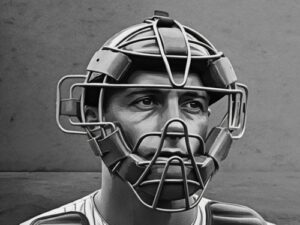If nickname quality was the most important criteria for election to the Baseball Hall of Fame, Tony Mullane would have been inducted decades ago. He was tabbed “The Apollo of the Box” by admiring newspaper reporters and fans in the 19th century.
Mullane is probably best known for being one of the first and most prominent players to pitch both right-handed and left-handed. Amazingly, he was not born ambidextrous, but rather taught himself to throw left-handed after he suffered an injury to his right shoulder. Subsequently, Mullane would often switch from his natural throwing arm to southpaw within the same game, inning, or even at-bat. Because he played in an era when few players wore gloves (and he rarely if ever did), Mullane could come to a set position with both hands on the baseball, and then choose to throw with either hand, confusing the batter.
But Mullane was not just a novelty, he was a talented pitcher and athlete. He often played in the outfield when he wasn’t pitching and hit very well. He earned playing time at first base because he was skilled at scooping throws from the dirt in his bare hands.
As a pitcher, Mullane was one of the most effective of the 1880s and early 1890s. He spent seven seasons in the American Association and six in the National League, ending his career in 1894 with the Cleveland Spiders, his eighth team. As was common with the best players of that era, Mullane was frequently switching clubs or jumping his contract to get more money.
From 1882 to 1894, Mullane’s 12 full seasons, only three other pitchers won more games in professional baseball than Tony. All three (John Clarkson, Tim Keefe, and Old Hoss Radbourn) have earned election to the Hall of Fame. In total, Mullane garnered 284 wins, the second highest sum among pitchers not enshrined in Cooperstown (Bobby Mathews won 297).
In some ways, Mullane was the Rasputin of baseball. He was beloved by female fans, almost to an obsession. He had striking good looks and strong features, but he cared little for his personal appearance. He often wore suit jackets until the elbows wore out, and according to some reports he rarely shaved and showered on a regular basis. One teammate claimed that Mullane wore his uniform for the entirety of a 10-day road trip, sleeping, carousing, and pitching in it. He won four games on the trek.
Mullane was so popular with women that many opposing teams held “Ladies Day” specials on days that he was scheduled to pitch. Once in a home game in Toledo, Mullane received $50 in gold coins, a silver drinking cup, a set of fine china, and a hunting rifle from admiring members of a woman’s civic organization. After tossing a no-hitter for Louisville in 1882, he was presented a quilt by appreciative female rooters.
In the prime of his career, Mullane missed an entire season when he was suspended after jumping his contract and joining the Cincinnati Red Stockings. For that indiscretion he sat out the 1885 season, after having won 36 games for Toledo the previous season.
Mullane was very popular, a flamboyant performer, an excellent defensive player, and an above average offensive player. However, in an era when teams carried maybe 2-3 pitchers and the aces usually won 30-40 games, Mullane was not an exceptional winner. His career .563 winning percentage is among the lowest of the big name pitchers of that era. His 3.05 ERA is also much higher than his contemporaries who are in the Hall of Fame, like Clarkson, Keefe, Radbourn, and Mickey Welch. Non-HOFers of that era like Gus Weyhing, Guy Hecker, Charlie Buffinton, and Ed Morris all posted lower ERA’s while winning a higher percentage of their games.
Because of his lower winning percentage and higher ERA, and the fact that he failed to hit the magic 300-win mark, Mullane’s name was left out of the circle of elite pitchers of his era. But probably even more damning to his reputation is the fact that Mullane did not perform well once the pitchers’ mound was moved back. For much of his career, Mullane threw from the 55-foot distance, but in 1894 the mound was moved back to 60-feet and some change. While many pitchers of that era like Cy Young, were able to dominate under both sets of rules, Mullane was never able to adjust. He posted a 6.59 ERA in 1894 while tossing for three teams. He left the game after that single season of pitching from 60-feet out.
After his playing career, Mullane remained popular, especially in Cincinnati, Louisville, and Toledo, where he had pitched most of his career. The Irishman (he was born in Cork, Ireland) moved to Chicago and became a policeman, spending nearly three decades in the uniform of that force.
Mullane’s stats are good but not great, and there are several other 19th century pitchers in the Hall of Fame already – it’s not clear that more are worthy. Even if a few more 19th century pitchers deserve plaques in Cooperstown, Bob Caruthers, Jim McCormick, and Larry Corcoran have better numbers. Mullane’s best argument is probably the novelty of his righty/lefty pitching and his tremendous popularity.






